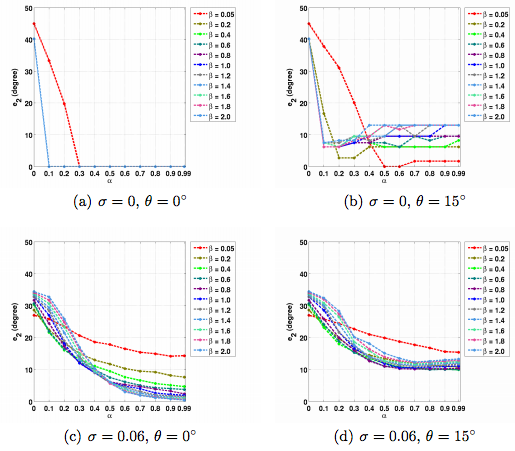A Bayesian Approach to Distinguishing Interdigitated Muscles in the Tongue from Limited Diffusion Weighted Imaging
A Bayesian Approach to Distinguishing Interdigitated Muscles in the Tongue from Limited Diffusion Weighted Imaging
Chuyang Ye, Aaron Carass, Emi Murano, Maureen Stone, and Jerry L. Prince
Introduction
Fiber tracking in crossing regions is a well known issue in diffusion tensor imaging (DTI). Multi-tensor models have been proposed to cope with the issue. However, in cases where only a limited number of gradient directions can be acquired, for example in the tongue, the multi-tensor models fail to resolve the crossing correctly due to insufficient information. In this work we address this challenge by using a fixed tensor basis and incorporating prior directional knowledge.
Method
We use a multi-tensor method that incorporates prior directional information within a Bayesian framework to resolve crossing fibers with limited gradient directions. Then we use a fixed tensor basis and estimate the contribution of each tensor using a maximum a posteriori (MAP) framework. The prior knowledge contains both directional information and a sparsity constraint, and a data fidelity is modeled in the likelihood. The resulting objective function can be solved as a noise aware version of a weighted ![]() -norm minimization [Candes et. al.]. The method is evaluated on in-vevo tongue diffusion images.
-norm minimization [Candes et. al.]. The method is evaluated on in-vevo tongue diffusion images.
Results
We started with a digital phantom. A 3D crossing phantom with two tracts crossing at 90◦ was generated to validate the proposed algorithm (fig. 1 for an axial view). Twelve gradient directions were used. CFARI [Landmen et. al.] and our proposed method were applied on the phantom. First we used horizontal and vertical directions as PDs for the horizontal and vertical tracts, respectively. Fig. 1(b) shows an example of reconstructed directions and is compared with CFARI results in Fig. 1(a). Next we studied the effect of inaccurate PDs. To introduce errors in the PDs, we rotated the true directions by 0 = 15 degrees to obtain PDs. We tested two cases of rotations: in and out of the axial plane. The results are shown in figs. 1(c) and 1(d) for the two cases respectively. In both cases, the proposed method correctly reconstructs non crossing fiber directions.
Then to make the simulation more realistic, we added Rician noise to the digital noise to the digital phantom. What we discovered is that in both noisy and noise free cases it is still possible to obtain crossing directions that are close to truth with proper r α and β. Note that in crossing regions, CFARI cannot find the correct crossing directions. In these examples, the errors of the proposed method can be smaller than the errors introduced in the PDs, which indicates that the proposed result is a better estimate than simply using the prior directions as the estimate.
Next we applied our method to in vivo tongue diffusion data of a control subject. Figures 2 and 6 show some of the results of our tests.
|
|
Conclusion
We have introduced a Bayesian formulation to introduce prior knowledge into a multi-tensor estimation framework. It is particularly suited for situations where acquisitions must be fast such as in in vivo tongue imaging. We use a MAP framework, where prior directional knowledge and sparsity are incorporated in the prior distribution and data fidelity is ensured in the likelihood term. The problem is solved as a noise-aware version of a weighted ![]() -norm minimization. Experiments on a digital phantom and in vivo tongue diffusion data demonstrate that the proposed method can reconstruct crossing directions with limited diffusion weighted imaging.
-norm minimization. Experiments on a digital phantom and in vivo tongue diffusion data demonstrate that the proposed method can reconstruct crossing directions with limited diffusion weighted imaging.
Publications
- B.A. Landman, J.A. Bogovic, H. Wan, F.E.Z. ElShahby, P.L. Bazin, and J.L. Prince, "Resolution of crossing fibers with constrained compressed sensing using diffusion tensor MRI", NeuroImage, 59(3): 2175-2186, 2012.




